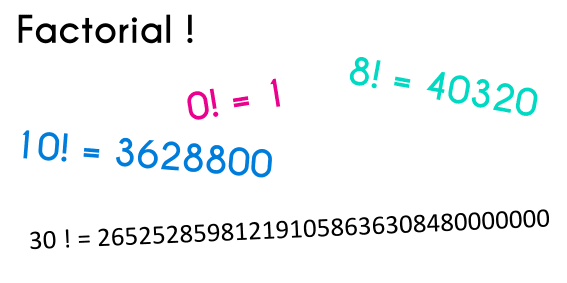Examples and definition of factorial
This article will be about The main concept and definition of factorial and when we can use it, also a list of the first 20 factorials and some solved examples.
¿What is a factorial number?
The factorial of a number is an operation that consists in multiplying a number “n” by every integer positive number below “n”, for example, the factorial of 3 is the result of multiplying 3 by 2 by 1. The factorial of a number can only be found in positive numbers, we cannot calculate the factorial of a negative number. This operation is represented by the number “n” followed by an exclamation mark, like this: 1!, 2!, 3!, 4!… n!

The factorial of a number can be used in various branches in mathematics and statistic, the factorials can be found in the combination and permutation formulas (links to these articles at the end of this page), and it is widely used in count, and actually, the factorial of a number is one of the many statistical methods, with the factorial we can find of how many ways the elements of a set can be ordered (without repetition), for example, to know of how many ways a group of 10 people can be ordered, the only thing we have to do is find the factorial of 10, and the result will be the answer, in this case the factorial of 10 is 3 628 800.
The result of the previous problem was 3 628 800, because this is the result of 10!, that is the multiplication of 10 * 9 * 8 * 7 * 6 * 5 * 4 * 3 * 2 * 1 = 3628800, and every problem similar to this is going to be solved the same way, just changing the value of “n” (calling “n” to the number of elements that are in a set).
While the “n” number increases, the result is going to have more and more digits, in the next table we are going to present the number figures of some factorials.
| n | Figures |
|---|---|
| 1 | 1 |
| 5 | 3 |
| 10 | 7 |
| 15 | 13 |
| 20 | 19 |
| 25 | 26 |
| 30 | 33 |
In this list we got until 30, that could be considered a small number, but 30! has 33 figures, and that is a huge number: 265 252 859 812 191 058 636 308 480 000 000 this is why some calculators only allow to find until the factorial of 69 (that number has 99 figures).
A property about this method is that the factorial of 0 is equals to 1, something that could sound a little without sense because there are no integer positive numbers below 0, but there are some reasons to think that 1 is the best answer to 0!
Examples of the first 20 factorials
In the following table we have the first 20 factorials, here we can see the huge growth of each factorial number.
| n | n! |
|---|---|
| 1 | 1 |
| 2 | 2 |
| 3 | 6 |
| 4 | 24 |
| 5 | 120 |
| 6 | 720 |
| 7 | 5 040 |
| 8 | 40 320 |
| 9 | 362 880 |
| 10 | 3 628 800 |
| 11 | 39 916 800 |
| 12 | 479 001 600 |
| 13 | 6 227 020 800 |
| 14 | 87 178 291 200 |
| 15 | 1 307 674 368 000 |
| 16 | 20 922 789 888 000 |
| 17 | 355 687 428 096 000 |
| 18 | 6 402 373 705 728 000 |
| 19 | 121 645 100 408 832 000 |
| 20 | 2 432 902 008 176 640 000 |
As we can see the number of figures that has the factorials greater than 10 are big, this is why when we use a formula or equation that includes factorials, we have to find the way to simplify the factorials because it is not easy to work with big numbers.
Factorial examples
Example 1 Calculate the factorial of 3
n = 3 3! = ?
- 3! = 3 * 2 * 1
- 3! = 6
Example 2 Calculate the factorial of 7
n = 7 7! = ?
- 7! = 7 * 6 * 5 * 4 * 3 * 2 * 1
- 3! = 5 040
Example 3 Find the factorial of 11
n = 11 11! = ?
- 11! = 11*10*9*8*7*6*5*4*3*2*1
- 11! = 39 916 800
Example 4 ¿of how many ways can 8 people order in a line?
n = 8 8! = ?
- 8! = 8*7*6*5*4*3*2*1
- 8! = 40320
Example 5 ¿How many combination of characters can we make out of d, t, o, s and q?
n = 5 5! = ?
- 5! = 5*4*3*2*1
- 5! = 120
Example 6: Solve the following operation with factorials
-
2 016 * 5!2 * 8!
- What we usualy do when we have factorials is to decompose the greatest factorial and then simplify the formula
-
2 016 * 5!2 * 8*7*6* 5!
- In this case we cancelled 8! until 5! to simplify it with the 5! in the top
-
2 016 *
5!2 * 8*7*6*5! - Now we have to solve the remaining operations
-
2 016 2 * 8*7*6*
-
2 016 672
-
2 016 672
- R// 3